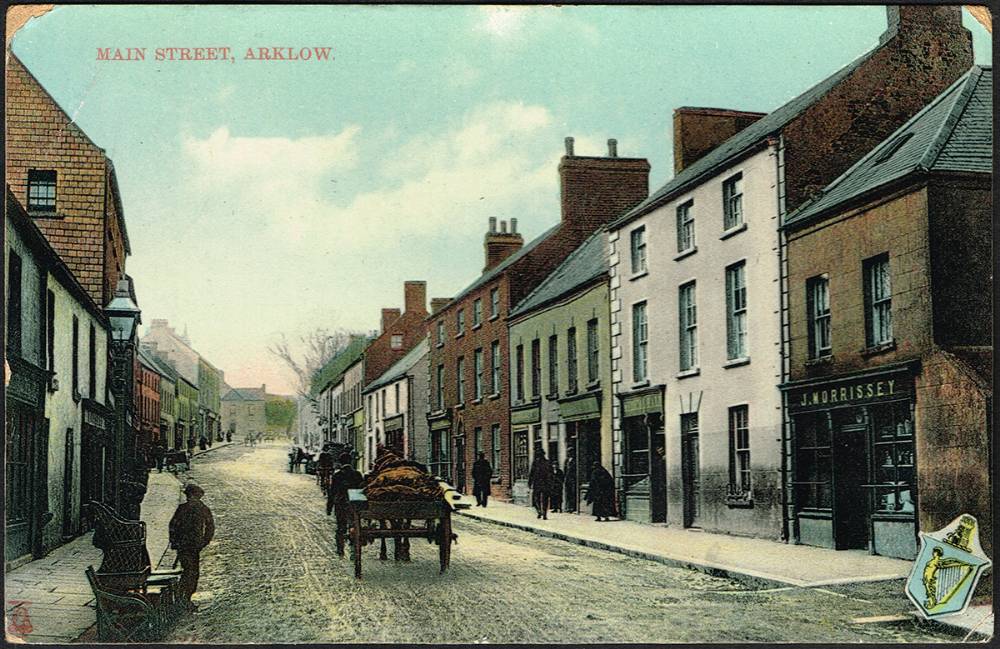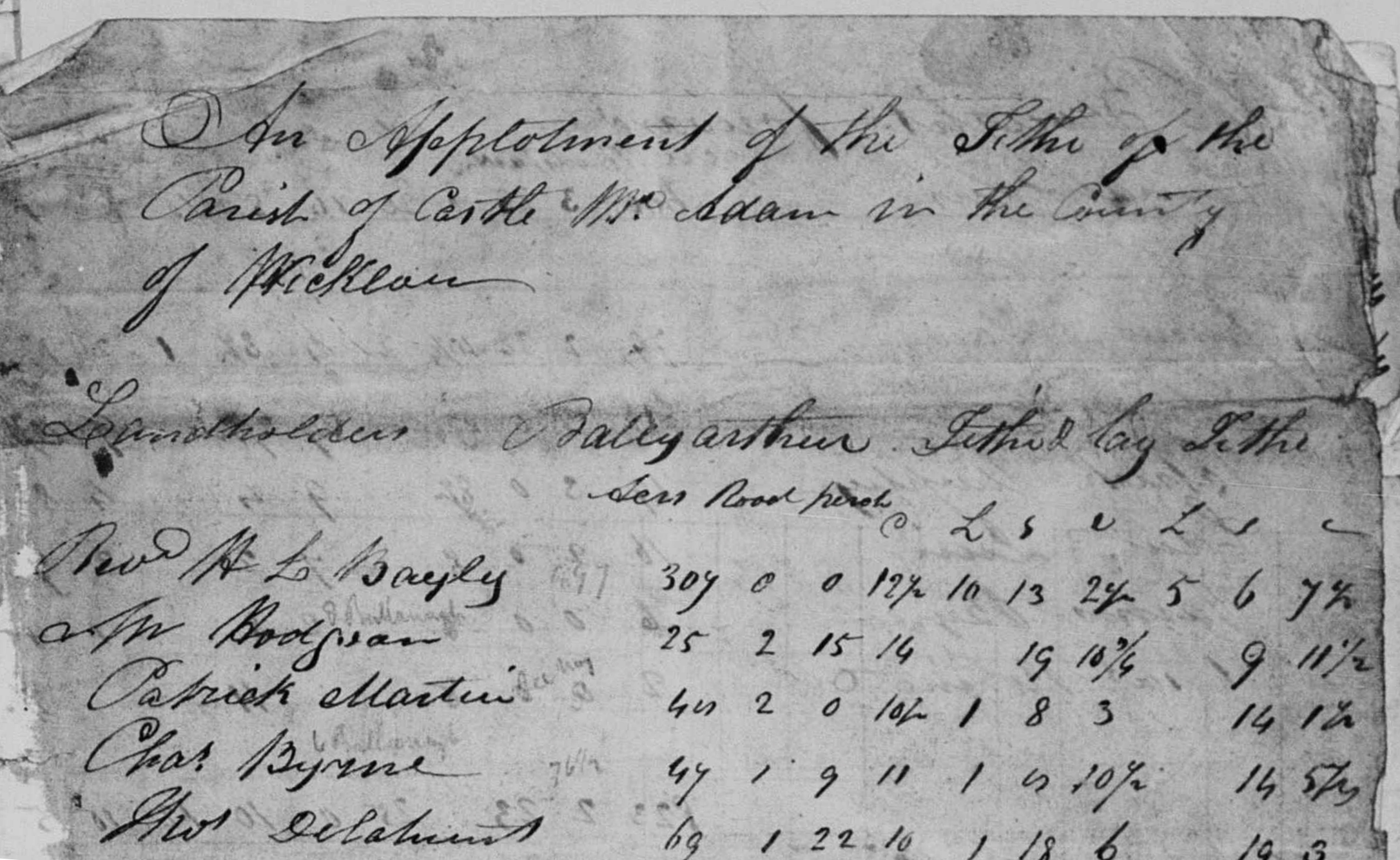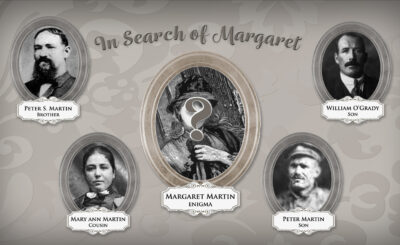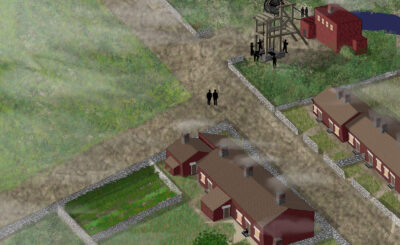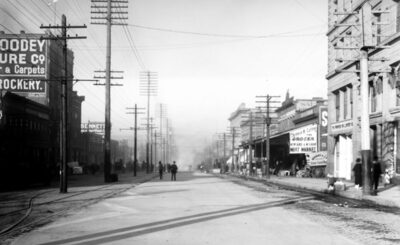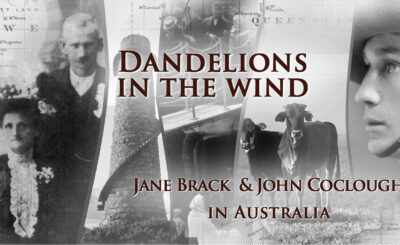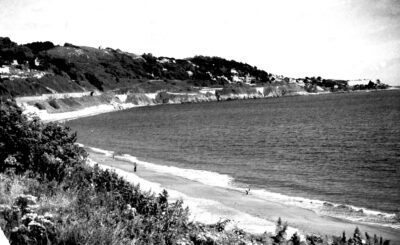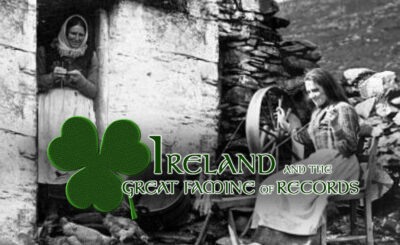Arklow is a seaport, market town and parish, in the county of Wicklow, 46 miles [south] from Dublin, 11 [southeast] from Rathdrum, and 10 [north] from Gorey; situated on the shore of St. George’s Channel, close to the border of Wexford County, and at the mouth of the river Avoca. The town consists mainly of one long street, tolerably well paved, the church and courthouse being conspicuous ornaments; but that portion of the town near the sea is composed of sorry huts or cabins, occupied by fishermen…. The herring fishery, formerly so productive, has, for several years past, yielded nothing, the fish having deserted this coast, which has been calamitous to the numerous fishermen; but oysters are obtained in great plenty…..
The beautiful scenery of the vale of Avoca, rich with mineral ores, including the romantic “Meeting of the Waters,” so sweetly sung by Moore, attract numbers to Arklow during the summer…. In 1841, the population of the parish of Arklow was 6,237, and that of the town 3,254.
It’s a well-established fact that in Ireland, records are hard to come by. The census records before 1901 are mostly lost to us. Statutory records began in the 1840s for marriages and the 1860s and 1870s for births and deaths—but before that only parish records were available, which are spotty, with records missing, too faded to read, or never recorded. Add to that the repetition of names generation after generation, and you have a puzzle worthy of the efforts of a master sleuth.
However, in the case of Stephen Martin, a bit of luck was on our side.
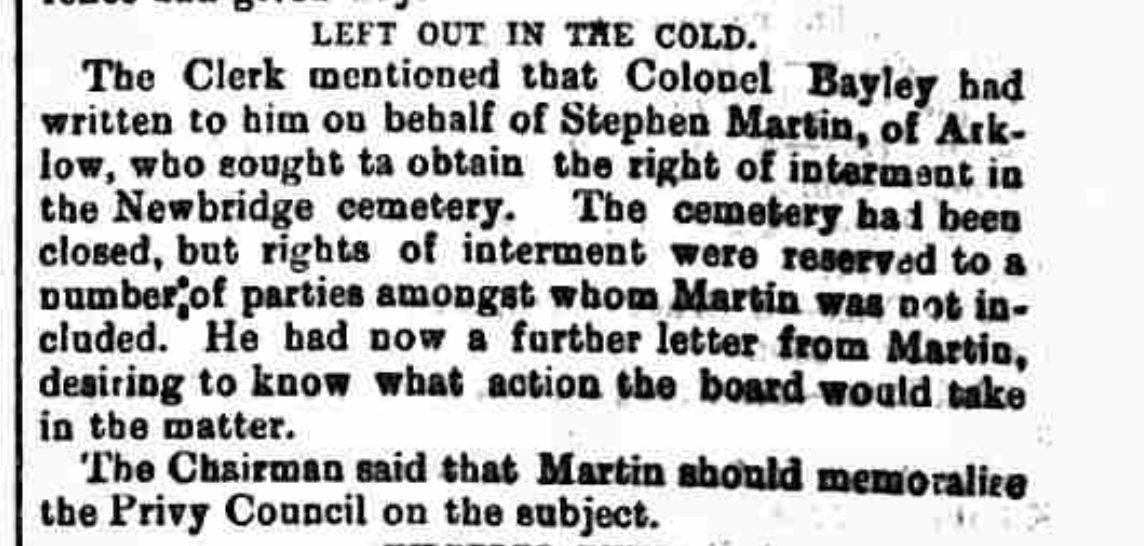
It’s always a big day when a new DNA match appears in our Martin line! Recently, however, we hit the jackpot, a Martin descendant with the surname Martin. We were able to find reliable records to trace the pedigree as far back as Stephen Martin of Arklow, County Wicklow—there the trail threatened to dry up in the pre-statutory records waste land. There were five Stephen Martins living in County Wicklow at that time, and probably most of them were related to one other. Trying to separate “our” Stephen Martin’s details from the others would not be easy. Stephen Martin lived in Arklow, according to his children’s christening records, but he never appeared in directories, in Griffith’s Valuation, or anywhere else helpful. (See Fig. 1.)
Stephen married Elizabeth Cole in Arklow on July 6, 1850,2 and parish records showed them having five children between 1851 and 1860: Patrick (1851), William (1854), Ignatius (1856), Patrick (1858—likely the first Patrick died in infancy), and Mary (1860). These children have also been elusive: we know Ignatius married and moved to Dublin where he eventually worked as a stableman, and we know that Mary never married and was living with Ignatius and his family on the 1911 Census.3 The other siblings have been difficult to trace, and may have died in one of the frequent cholera epidemics.
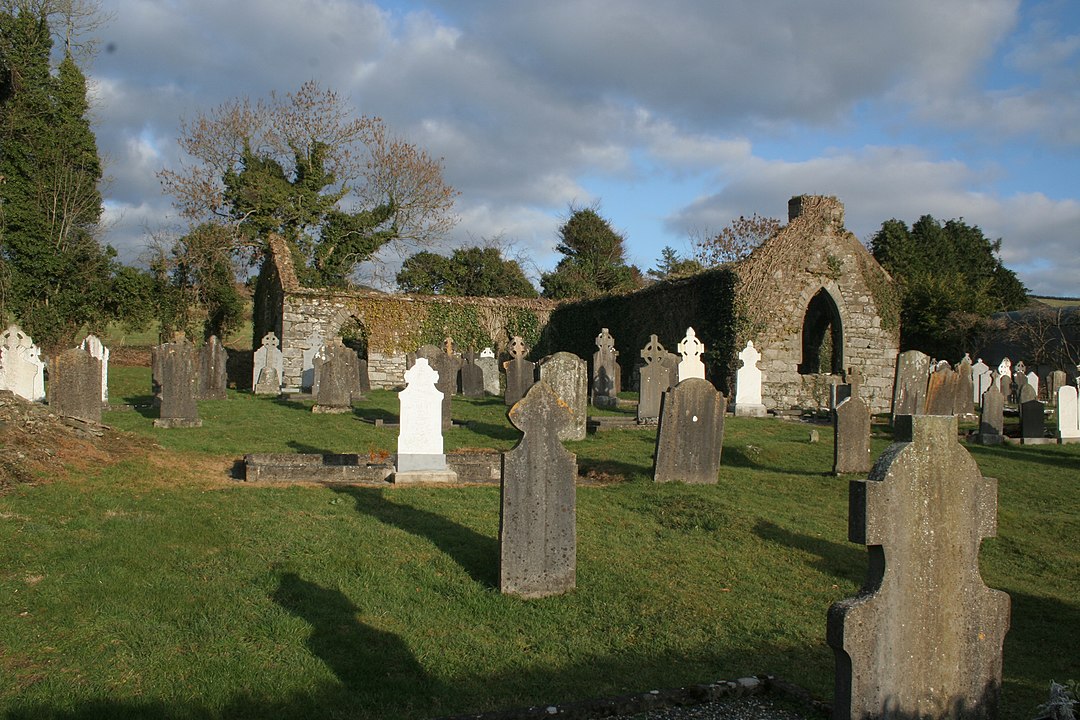
However, in an unfortunate (for them), fortuitous (for us) turn of events, Elizabeth Cole Martin died shortly after Mary was born. Stephen remarried a woman named Jane Byrne in 1864—just late enough to have a statutory record to document the occasion (see Fig. 2). Stephen and Jane had three children together: Ann Martin, born in 1866, died the same year; Michael John Martin, born in 1867, went to England, then Wales where he married Alice Maud Rose and they raised a family; Stephen and Jane’s youngest child, Catherine, was born in 1868 and died in 1870.
Stephen and Jane’s marriage record, however, opened new doors. We learned that Stephen was a carpenter and that his father was Patrick Martin, a farmer. Knowing that Stephen was a carpenter, it wasn’t too hard to find his death record: Stephen died February 15, 1897, at the reported age of 80 years old, which gives him a birth year of ca. 1817. The death record showed his occupation as carpenter, the witness present at his death as “Mary Martin / daughter,” and that he was a “widower.” (Jane Byrne Martin had preceded him in death in 1877.) These facts combine to give a high confidence rating to this being “our” Stephen Martin (see Fig. 3).
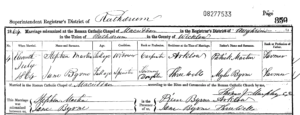

The next big piece of the puzzle is to identify Stephen Martin’s father, a fairly daunting task. But knowing his name, Patrick Martin, and his occupation, farmer, proved to be helpful. In 1824, Ireland undertook a survey of all farm lands to determine how much tax or “tithe” each farmer should pay. The survey was called the Tithe Applotment as its purpose was to allocate funds to the local Church of Ireland leaders to take care of the sick and poor. (That most of the Irish farmers were Catholic didn’t seem to matter to the powers that be.) Two men named Patrick Martin appeared as farmholders in County Wicklow in the Tithe Applotment (1824): Patrick Martin of Derrynamuck in the Donaghmore parish and Patrick Martin of Ballyarthur in the Castlemacadam parish.4

The townland of Derrynamuck was quite small (278 acres) and Ballyarthur was not much bigger in size (448 acres). Both townlands contained only a few families, and although the land records only listed the name of the person who held the rental agreement, multiple generations would often live on each farm or in each house. Although the census forms from 1841 to 1881 are not available, census reports that aggregated the information were published5 and do give some insights (see Figure 4), especially when correlated with Griffith’s Valuation.
Griffith’s Valuation showed these family names in Derrynamuck in 1854: Perry, Byrne, Donohoe, Martin, and Hoxley.6 The census chart (Fig. 4) shows that in 1861 there were 21 people living in four houses among these five surnames.
Griffith’s Valuation showed these family names in Ballyarthur in 1854: Martin, Monahan, Bayley, Brien, Parle, Maher, and Morgan. The census chart (Fig. 4) shows 43 people living in seven houses among these seven family names. 7
It’s easy to see that a person with a birth, death, or marriage record from one of these small townlands was very likely to be close family to residents with the same surname.
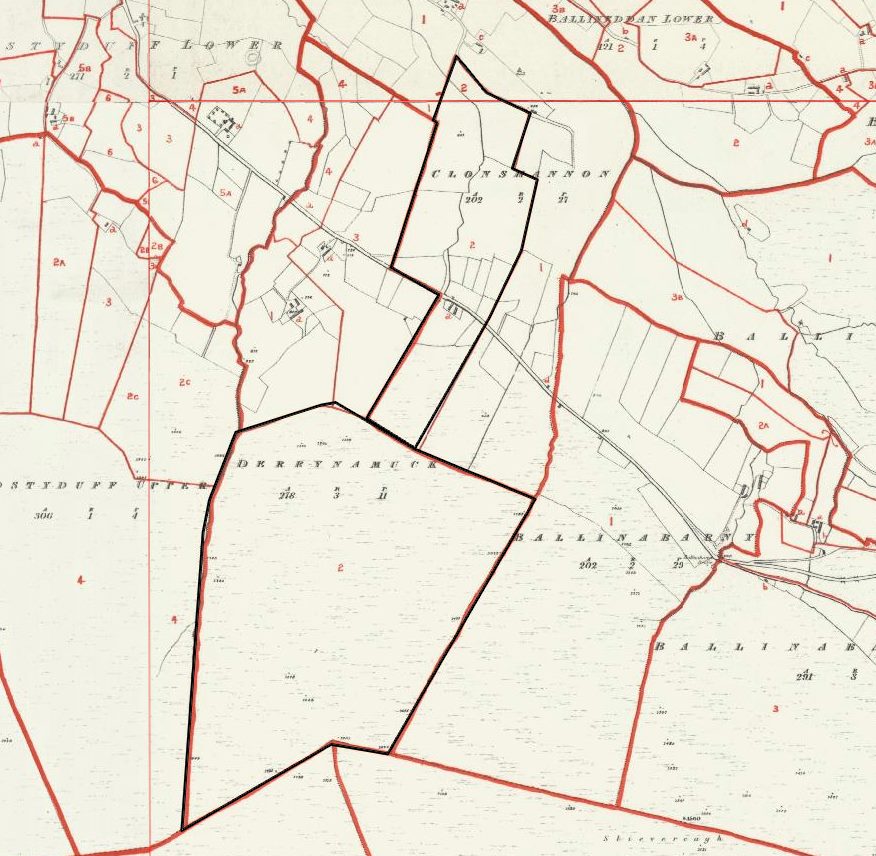
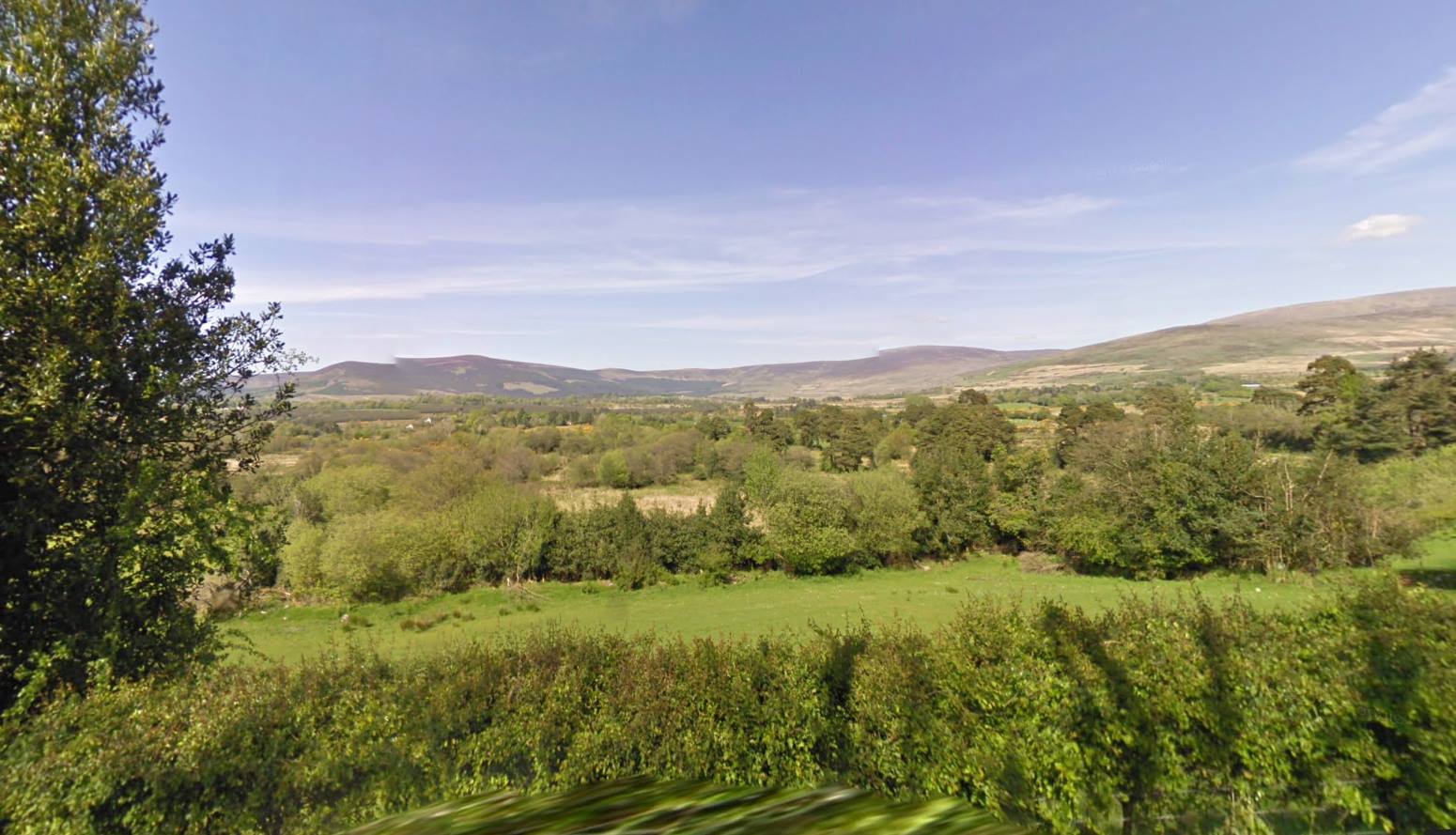
(Click to enlarge.)
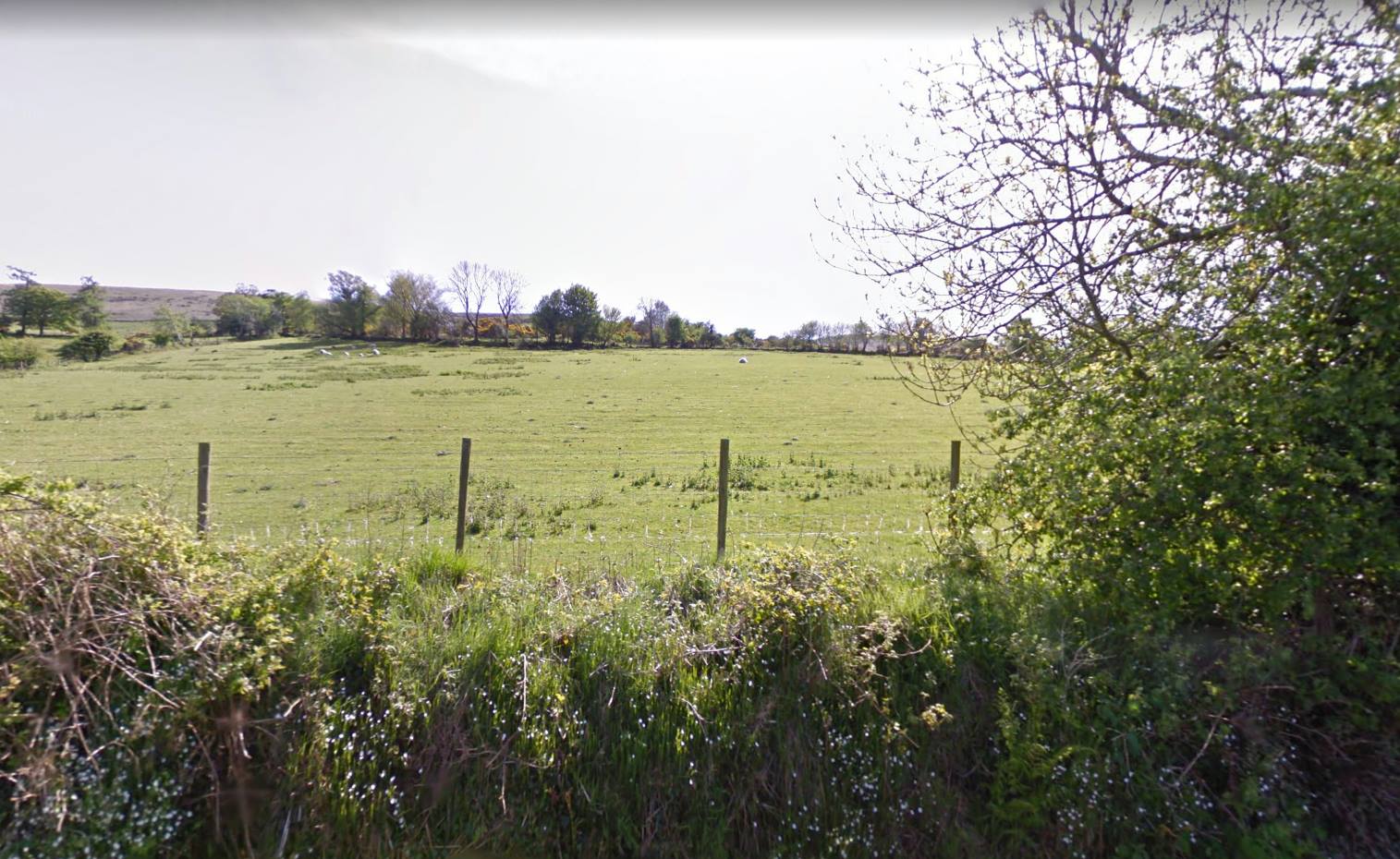
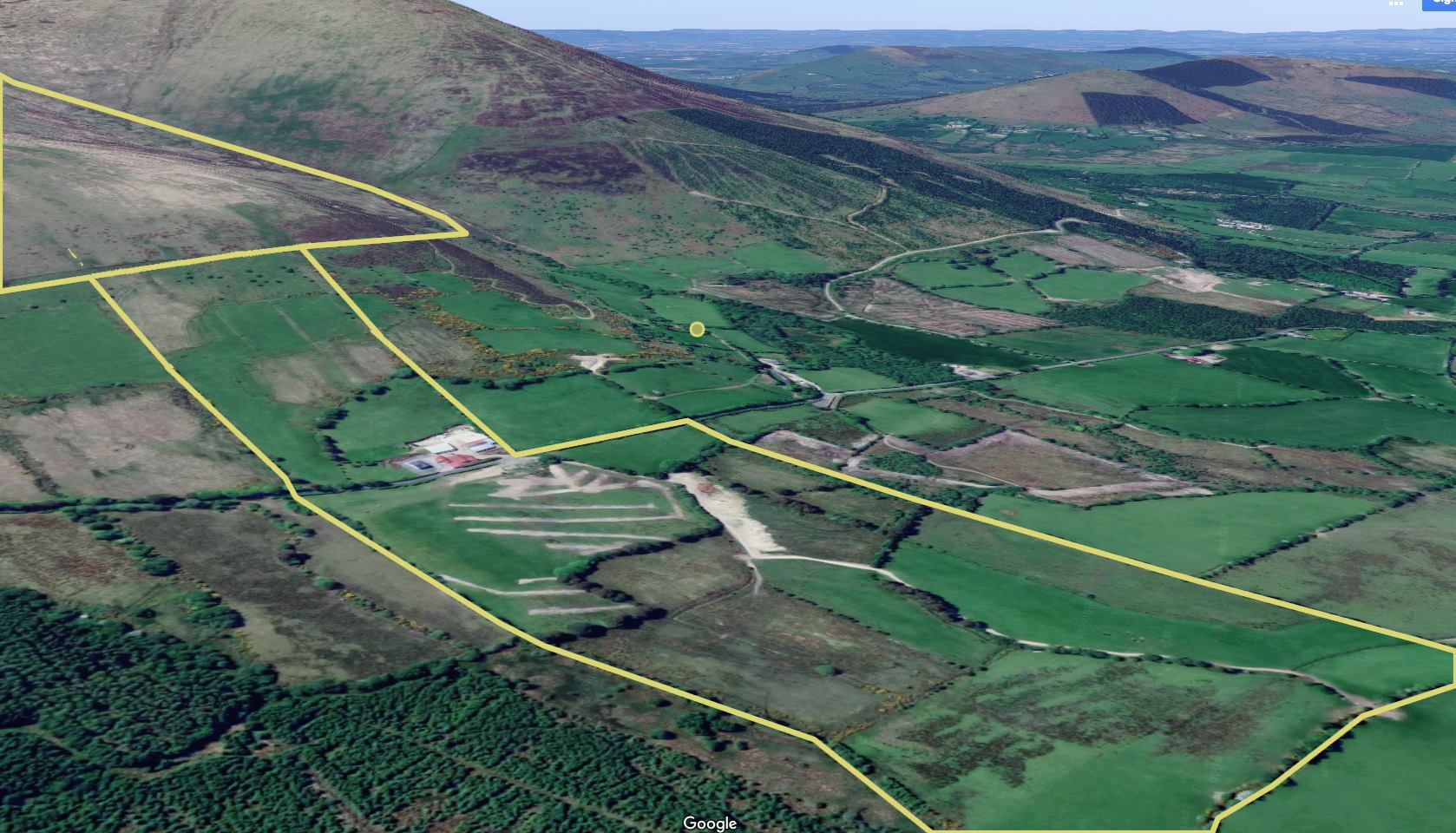
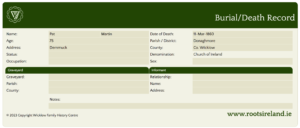
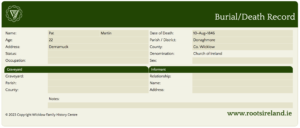
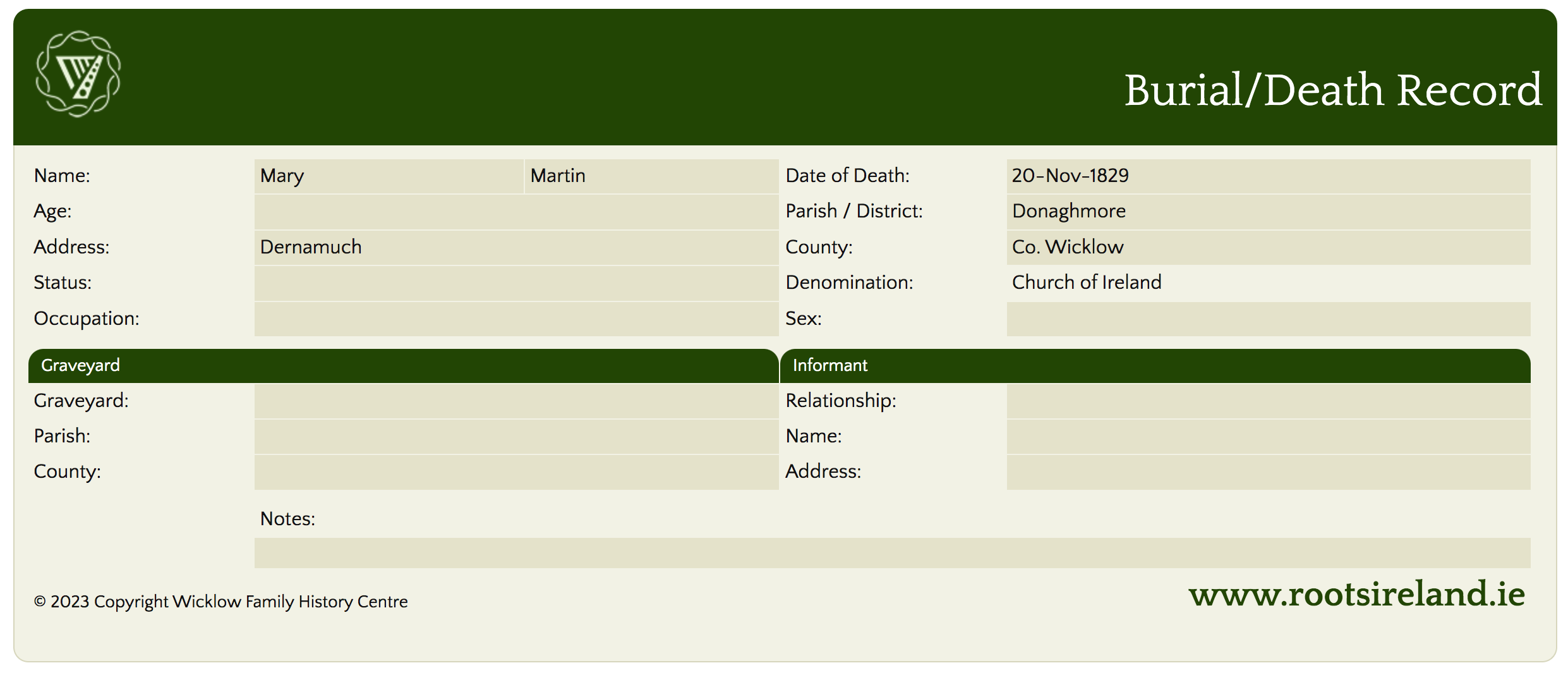
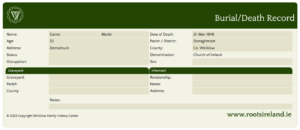
Patrick Martin of Derrynamuck
Patrick appears in several places in parish records: he and his wife Ann are named in christening records that identify three children: Elizabeth, born in 1816, is believed to have married James McCabe and eventually they went to Liverpool; William, born in 1819, married Rosanna Brack and went to Airdrie, Scotland, where he died in a mining accident in 18528; Patrick, born in 1822, apparently died in 1846, at the height of the famine (see Fig. 10). Burial records suggest Patrick and Ann may have had other children: Mary Martin died in 1829 at Derrynamuck, but her birth year is not known.(See Fig. 11.) She may have been a child of Patrick and Ann who died young, or Patrick’s sister or mother. Garret Martin died at Derrynamuck in 1846 at the age of 22, giving a birth date of ca. 1824. (See Fig.12.) He may also be the son of Patrick and Ann, although without a birth record, one cannot be certain.9
Patrick Martin shows up as a farmer at Derrynamuck on the Tithe Applotment survey (1824), and at Derrynamuck and an adjacent property of Clonshannon on Griffith’s Valuation (1845-1860). We have no record of Ann’s death, but Patrick was buried in 1860, at the age of 75, giving him a birth date of 1785 (see Fig. 9).
The townland of Derrynamuck was the scene of a significant event in the Irish Rebellion of 1798. In February 1799, the rebel Michael Dwyer took shelter at Miles Connell’s cottage during a snowstorm with some of his men. The British forces had repeatedly been frustrated in their attempts to capture Dwyer, so when the British discovered the rebels were nearby, the soldiers surrounded the Connell cottage, and demanded Dwyer and his men surrender. Although the British set fire to the thatched roof of the cottage, wily Michael Dwyer managed to escape, but his men were all killed or captured in the skirmish.10 If Patrick Martin was living in Derrynamuck at the time, he would have been 14 years old. Figure 8 shows the proximity of Miles Connell’s cottage to the Derrynamuck farmlands.
Could Stephen Martin be the son of Patrick Martin, the farmer from Derrynamuck? He very well could be—the strength of the DNA match says there is a 72% chance that the most recent common ancestors between Stephen Martin’s descendants and those of William Martin and Rosanna Brack occur in this generation.11
If that’s the case, Patrick and Ann’s family may have included as many as six children (names with asterisks supported by records; others are speculative):
- * Elizabeth Martin, born in 1816; married James McCabe in 1836.
- Stephen Martin, born in 1817; married Elizabeth Cole in 1850 and Jane Byrne in 1964; died in 1897.
- * William Martin, born in 1819; married Rosanna Brack in 1839; died in 1852.
- * Patrick Martin, born in 1822; died in 1844.
- Garrett Martin, born in 1824; died in 1846.12
- Mary Martin, died in 182913
Unfortunately, we can only surmise unless and until new records turn up.
RELATED CONTENT—”William Martin, Death of a Scottish Miner”
Patrick Martin of Ballyarthur
Little is known about Patrick Martin of Ballyarthur, except that he appears in the Tithe Applotment survey, on a farm of what appears to be 45 acres.14 He does not appear in Griffith’s Valuation ca. 1845, so he had probably died before then. There is, in fact, a grave record for one Patrick Martin in the Avoca Old Cemetery. Although no photo is available, the transcribed record says that Patrick Martin was born in 1796 and died February 13, 1834, at the age of about 37.15 If this is Patrick of Ballyarthur—he appears to be the best candidate—the timing of his death fits well the facts that Patrick appeared in the Tithe Applotment survey, but not in Griffith’s Valuation.
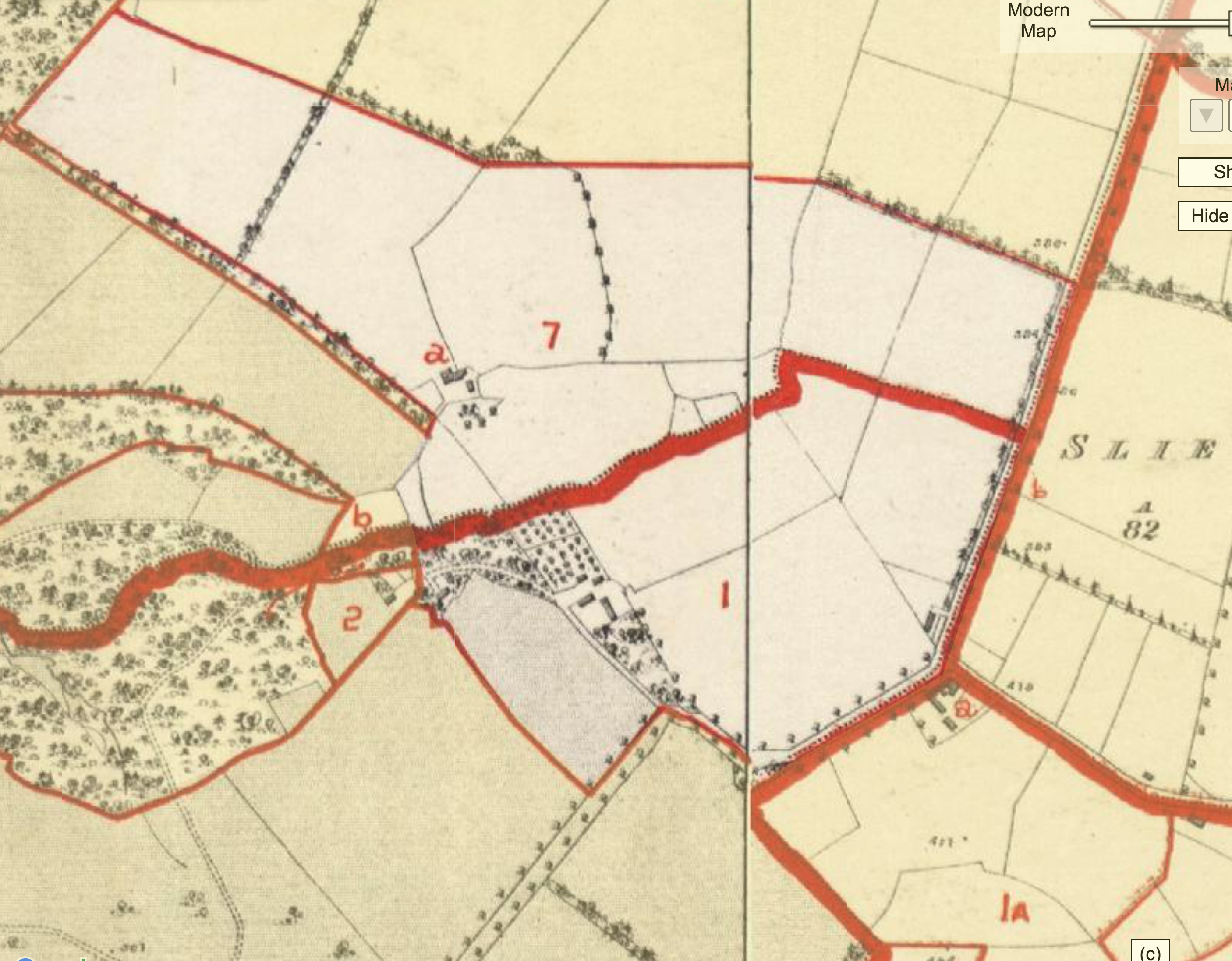
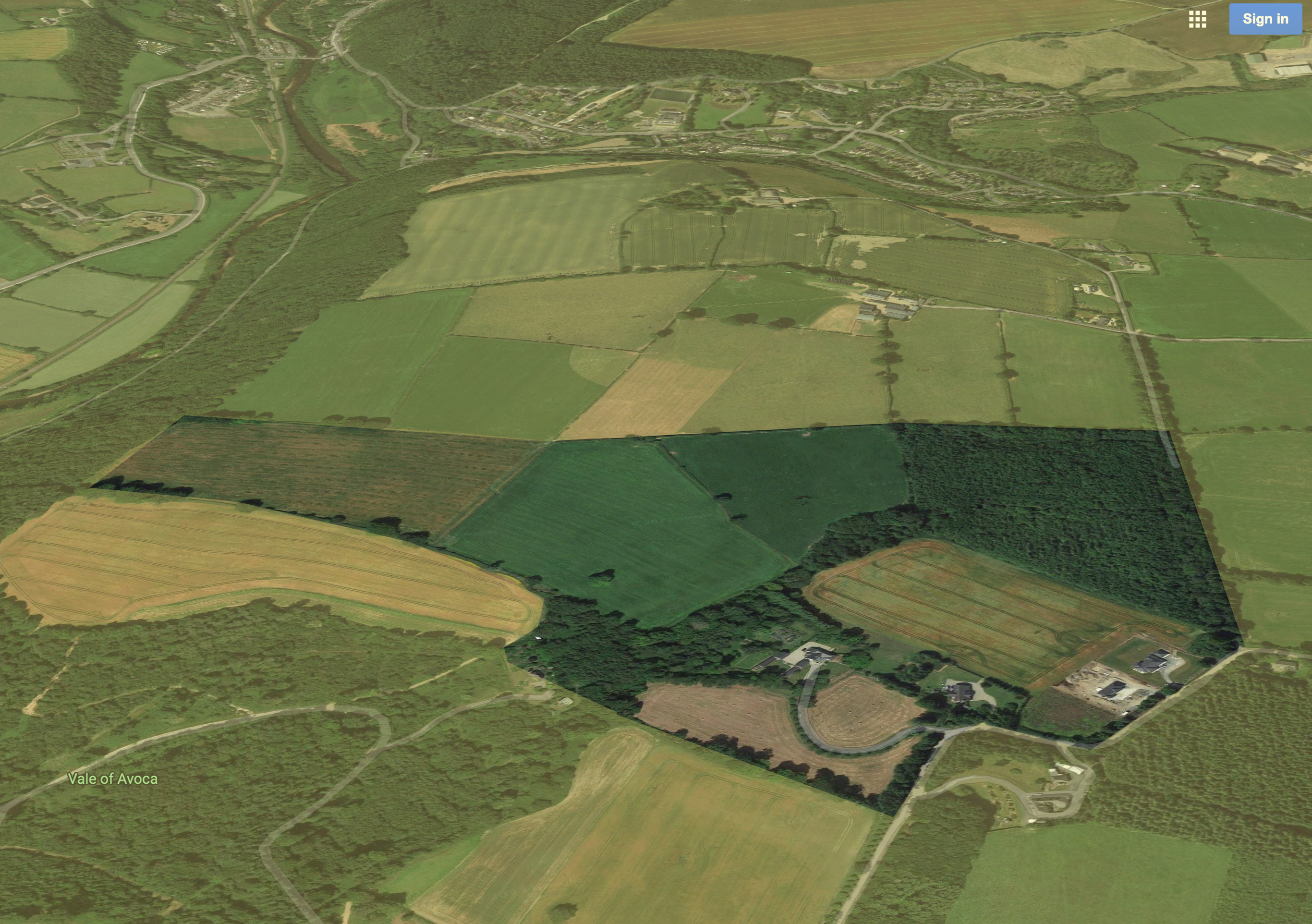
But there is another farmer named Martin in Ballyarthur in Griffith’s Valuation that could be Patrick’s son. Eneas Martin appears in Valuation Office Books (notebooks used to prepare Griffith’s Valuation) as early as 184116, which supposes Eneas was born no later than 1820 or so. He has two adjacent plots of farmland, one in Ballyarthur and one in Ballanagh. Eneas Martin appears in the Valuation Office books until 1853, but by the 1901 Census there are no Martins in Ballyarthur or Ballinaugh. Despite the lack of records, there are several details that suggest Eneas may be Stephen Martin’s older brother.
- “Eneas” is a variant of “Ignatius,” which is an unusual name in Ireland.
- There is a christening record dated March 21, 1834, for Biddy Martin, born in Avoca. Her parents are shown as “Ignatious Martin” and “Biddy Byrne.” Avoca is about two miles from Ballyarthur.17
- Bridget Martin married Michael Duffy on June 26, 1862. Her father’s name was shown as “Ignatii” and the mother as “Bridget” on the parish marriage record. A note on the transcribed record says her parents were from Ballyarthur.18
There is a strong case to be made that Eneas is Ignatius Martin, and that he was the son of Patrick Martin, since Eneas appears to have assumed Patrick’s farmlands in Ballyarthur. Following Irish traditions, parents would name their children after their grandparents, parents, and siblings. That Stephen named his first son Patrick and his second son Ignatius adds to the likelihood that Stephen was part of this family, that Eneas was Stephen’s brother. The common names, the occupation of Patrick, and the proximity are strong circumstantial indicators that Stephen Martin, the carpenter of Arklow, was the son of Patrick Martin, the farmer from Ballyarthur. On the other hand, Patrick would have had to marry and have children quite young to be the father of Stephen born in 1817, and Eneas probably before then. However, marriage at age 119 is not unheard of. Additionally, If this Patrick is the father of our Stephen Martin, it places the common ancestor for the two Martin lines two generations further back, since it is unlikely there were two sons named Patrick in the same family. It is statistically unlikely that the two DNA contributors were fifth cousins once removed. If new records become available, or if other descendants do DNA testing, we may be able to further prove or disprove the relationship, but for now the preponderance of evidence still places Patrick of Ballyarthir and Stephen of Arklow as father and son.
There are other records for Martins in the area around Ballyarthur that suggest Patrick may have had other children besides Stephen and Ignatius:
- The record for Patrick’s death and burial in Old Avoca cemetery associates him with a son, William Martin, who was born in 1832 and died September 12, 1848.19
- Griffith’s Valuation shows Joseph Martin rented a house in Upper Kilmacoo in the parish of Castlemacadam. Upper Kilmacoo is about five miles north of Ballyarthur. His age is not known.
- There is a death record for the widow Sally Martin from Ballyarthur who died May 31, 1887, at the age of 69. That puts her birth year at 1818. To whom was she married?20
- Patrick Martin married Rebecca Dunne on December 11, 1838, in Ballinastraw, just three miles north and east of Ballyarthur.21 Patrick’s occupation was listed as a farmer, but there is no land assigned to him in the vicinity. Rebecca’s mother, Lucy Dunne, held nine acres of land in Ballinastraw, and that’s probably the land that Patrick farmed. Rebecca and Patrick had three daughters, Lucy, Rebecca, and Mary Ann. Their mother died in 1847, and it’s not clear what happened to Patrick and Lucy. However, when Lucy Dunne emigrated to Auckland, New Zealand, she took Mary Ann and Rebecca Martin with her.
Were each of these people children of Patrick of Ballyarthur? Probably not—there’s just not enough information to tell what the exact relationships were, although they probably were related in some way if not siblings. But if they were all siblings, the family may have looked like this:
- Eneas/Ignatius Martin, the farmer, who married Bridget Byrne; they had one known daughter, Bridget Martin. (He is assumed to be the oldest since he took charge of his father’s farm.)
- Patrick Martin, who married Lucy Dunne; they had Lucy, Rebecca, and Mary Ann.
- Stephen Martin, carpenter of Arklow, who married Elizabeth Cole and Jane Byrne.
- Sarah Martin’s husband
- William Martin, born 1832 and died September 12, 1848.
Reality Check Time
It can be very easy to get carried away when piecing bits and bobs of information together. Stephen may have moved to the area from County Meath and have no near relatives in county Wicklow. He could have been named after his mother’s grandfather Stephen Murphy, and have no other Martin relatives named Stephen. It’s possible that the Stephen Martin who married Elizabeth Cole was not the same Stephen Martin who married Jane Byrne. All sorts of odd happenings may have happened, because that’s the nature of life both now and then. However, having DNA evidence that ties Stephen Martin to other Martins in the area helps. And, well, we just do the best we can.
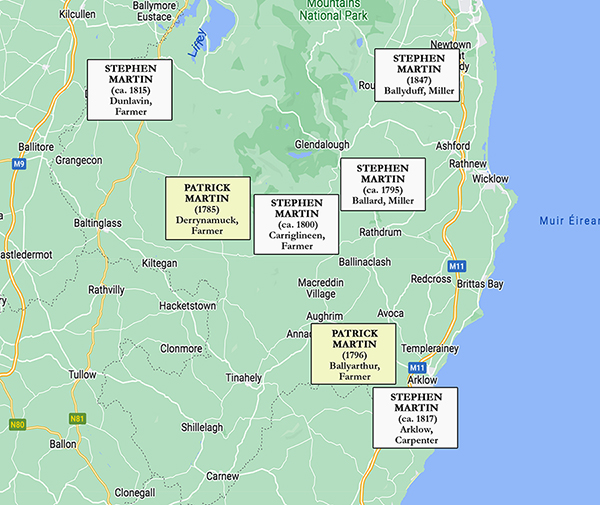
There is one more unanswered question to consider. Since DNA testing has shown that the descendants of Stephen Martin the carpenter and Patrick of Derrynamuck have ancestors in common, can we tell how these two men are related? Unfortunately, not yet. However, it is worth noting that there are five different families headed by a Stephen Martin in this part of County Wicklow—the Stephens could be related, having inherited the name from common ancestors.
- Stephen Martin (born ca. 1795) of Ballard was a miller. He married Bridget York, and they had sons named Patrick, Stephen, and Garret.22
- Stephen Martin (born ca. 1800) of Carraglineen was a farmer. He married Frances (Fanny) Morton, and they had sons named Michael, James, Patrick and Stephen.23
- Stephen Martin (born ca. 1817) of Arklow was a carpenter. He married Elizabeth Cole and they had sons named Patrick, William, and Ignatius.
- Stephen Martin (born ca. 1815) of Dunlavin was a farmer.24 He married Elizabeth (last name not known), and they had sons Thomas, Thomas, William, Stephen, and Thomas. He may have been one of the sons of Thomas Martin, butcher, also of Dunlavin.25 Thomas Martin married Catherine, and they had sons Thomas, William, (and possibly) Stephen.
- Stephen Martin (born 1847) of Ballyduff was also a miller.26 Son of William Martin (a shoemaker) and Catherine Kinsella, he married Margaret Byrne and they had sons named William and Michael.
Are these families related to each other? It seems that at least some of them must be. In time new DNA matches may appear to help clarify the connected lines.
As they say, records are hard to come by in Ireland. Scarce and sometimes ambiguous census records, statutory records, and parish records are to be expected, as are names being repeated generation after generation. Researching family in Ireland is rather akin to doing jigsaw puzzles blindfolded—puzzles with missing pieces, mixed-in pieces from an unknown number of other puzzles, and lacking edge and corners pieces to frame the picture. What’s not to love?
And so the puzzle continues.
NOTES
1.“Left Out in the Cold,” Wicklow People, May 23, 1891, 1.
2.“Elizabeth Cole,” in the Ireland, Catholic Parish Registers, 1655-1915 [database on-line]. Provo, UT, USA: Ancestry.com Operations, Inc., 2016. Original data: Catholic Parish Registers, National Library of Ireland, Ireland. https://www.ancestry.com/discoveryui-content/view/9804926:61039
3. “Ignatius Martin,” in the Web: Ireland, Census, 1911. Census of Ireland 1901/1911. The National Archives of Ireland. http://www.census.nationalarchives.ie/search/: accessed 31 May 2013. http://www.census.nationalarchives.ie/pages/1911/Dublin/North_Dock/Leland_Place/19863/. Note there were three women named “Mary” living in this house: his wife, his sister, and his daughter.
4. Does Stephen Martin’s father have to be one of these two men? No, he doesn’t. We are making an assumption that may prove to be incorrect. However, the first place to look for the father is at these two men. We can evaluate after further inspection and decide our degree of confidence in either candidate.
5.See Census of Ireland 1881: Area, Population and Number of Houses; Occupations, Religion and Education, vol. I, Province of Leinster (Dublin: Alexander Thomas & Co., 1881). The Castlemacadam information is on page 1096, and Baltinglass is on page 1120.
6. We are using Griffith’s Valuation to compare with the Census because the boundaries in the Tithe Applotment do not correlate well with townlands in the Census reports—acreage amounts do not match between the Tithe Applotment and the Census reports as they do with Griffith’s Valuation.
Griffiths Valuation source for Derrynamuck. Explanation as to why not using the Tithe Applotment, and why not counting Clonshannon and the other place. We are also not including the additional properties in other townlands that both families occupied to avoid double counting. “Patrick Martin,” in the Ireland, Griffith’s Valuation, 1847-1864 [database on-line]. Provo, UT, USA: Ancestry.com Operations Inc, 2008. Original data: General Valuation of Ireland. Dublin, Ireland: Irish Microforms Ltd., 1978. National Archives, Dublin and Public Record Office, Belfast. https://www.ancestry.com/discoveryui-content/view/1136682:1269
7. “Eneas Martin,” in the Ireland, Valuation Records, 1824-1856 [database on-line]. Lehi, UT, USA: Ancestry.com Operations, Inc, 2021. Original data: Valuation Office house, field, tenure and quarto books 1824 – 1856. Dublin, Ireland: Microfilm of original records held at the National Archives of Ireland. https://www.ancestry.com/discoveryui-content/view/1528610:62024
8. William Martin and Rosanna Brack were my great great grandparents. Many of their descendants have been located in Ireland, Scotland, England, Europe, the United States, and Australia.
9. A child named Garret Martin was born to Stephen Martin and Bridget York and christened on March 30, 1825, at Ballard in County Wicklow. Ballard is about 20 miles from Derrynamuck. Stephen and Bridget had other sons named John (b. 1820), Pat (1822), and Stephen (1827). There’s no way to know whether Garret Martin, who died in Derrynamuck, was the son of Stephen of Ballard or Patrick of Derrynamuck or someone else. However, the repetition of the same names—especially unusual ones like Garret—suggests a familial tie between the two Martin families.
10. See “Dwyer McAllister Cottage,” Wikipedia. https://en.wikipedia.org/wiki/Dwyer%E2%80%93McAllister_Cottage
11. This estimate of statistical likeliness is based on a DNA match of 30cM across 1 segment. If Patrick and Ann Martin of Derrynamuck are the common acestors, the genetic distance between the two people who donated samples is 9, which would make them third cousins once removed. Using Ancestry’s chart of probability, the likelihood that their relationship is closer than fourth cousins is 72%.
12. Burial/Death Record for: Garret Martin, RootsIreland.ie, 21 March 1848, Age 22, Dernamuck, Co. Wicklow. Donaghmore Parish, Church of Ireland. http://ifhf.rootsireland.ie/view_detail.php?recordid=23948&type=dch&recordCentre=wicklow&page=1&n=2
13. Burial/Death Record for: Mary Martin, RootsIreland.ie, 20 November 1829, Dernamuch, Co. Wicklow. Donaghmore Parish, Church of Ireland. http://ifhf.rootsireland.ie/view_detail.php?recordid=25085&type=dch&recordCentre=wicklow&page=1&n=3
14. “Patrick Martin,” in Tithe Applotment Records, Ballyarthur, County Wicklow, 1824, NationalArchives.ie.
http://titheapplotmentbooks.nationalarchives.ie/reels/tab//004587415/004587415_00087.pdf
15. See “Patrick Martin,” Old Avoca Cemetery, FindaGrave.com. https://www.findagrave.com/memorial/246236962/patrick-martin
16. “Eneas Martin,” in the Ireland, Valuation Records, 1824-1856 [database on-line]. Lehi, UT, USA: Ancestry.com Operations, Inc, 2021. Original data: Valuation Office house, field, tenure and quarto books 1824 – 1856. Dublin, Ireland: Microfilm of original records held at the National Archives of Ireland.https://www.ancestry.com/discoveryui-content/view/1528610:62024?tid=190063774
17. Birth/Baptism Record for: Biddy Martin, RootsIreland.ie, March 21, 1834. Avoca Parish, Roman Catholic. Father listed as “Ignatius Martin.” http://ifhf.rootsireland.ie/view_detail.php?recordid=61289&type=bch&recordCentre=wicklow&page=1
18. Church Marriage Record for: Michael Duffy and Bridget Martin, RootsIreland.ie, June 26, 1862. Arklow Parish, Roman Catholic. Father listed as “Ignatii Martin,” and a note states: “BRIDE’S PARENTS ADDRESS: BALLYARTHUR.” http://ifhf.rootsireland.ie/view_detail.php?recordid=70928&type=mch&recordCentre=wicklow&page=1
19. See “William Martin,” Old Avoca Cemetery, FindaGrave.com. https://www.findagrave.com/memorial/246236967/william-martin
20. Death of SARAH MARTIN in 1894, widow, age 74, Ballyarthur, Co. Wicklow, SR District/Reg Area Rathdrum, Group Registration ID 3583040 https://civilrecords.irishgenealogy.ie/churchrecords/images/deaths_returns/deaths_1887/06215/4778553.pdf
21. Church Marriage Record for: Patrick Martin and Rebecca Dunne, RootsIreland.ie, December 11, 1838, in Castlemacadam. http://ifhf.rootsireland.ie/view_detail.php?recordid=85700&type=mch&recordCentre=wicklow&page=1
22. Church Marriage Record for: Stephen Martin and Biddy York, RootsIreland.ie, August 26, 1821, from Ballard, County Wicklow, Roman Catholic. http://ifhf.rootsireland.ie/view_detail.php?recordid=96305&type=mch&recordCentre=wicklow&page=1&n=1&backLink=quis.php&sc=0
23. “Stephen Martin,” in the Ireland, Griffith’s Valuation, 1847-1864 [database on-line]. Provo, UT, USA: Ancestry.com Operations Inc, 2008. Original data: General Valuation of Ireland. Dublin, Ireland: Irish Microforms Ltd., 1978. National Archives, Dublin. https://www.ancestry.com/discoveryui-content/view/2632135:1269?ssrc=pt
24. “Stephen Martin,” in the Ireland, Griffith’s Valuation, 1847-1864 database on-line]. Provo, UT, USA: Ancestry.com Operations Inc, 2008. Original data: General Valuation of Ireland. Dublin, Ireland: Irish Microforms Ltd., 1978. National Archives, Dublin. https://www.ancestry.com/discoveryui-content/view/1153063:1269
25. Death of THOMAS MARTIN in 1878, age 94, Widower, butcher, Group Registration ID 7069913, SR District/Reg Area Baltinglass. https://civilrecords.irishgenealogy.ie/churchrecords/images/deaths_returns/deaths_1878/020512/7198079.pdf
26. “Stephen Martin,” in the Web: Ireland, Census, 1901 [database on-line]. Provo, UT, USA: Ancestry.com Operations, Inc., 2013. Original data: Census of Ireland 1901/1911. The National Archives of Ireland. http://www.census.nationalarchives.ie/search/: accessed 31 May 2013. http://www.census.nationalarchives.ie/pages/1901/Wicklow/Arklow_Rural/Ballyduff_North/1812849/

